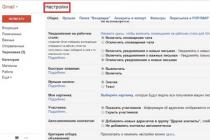When did social networks, such as theFacebook, VKontakte andTwitter, our world is divided into online and offline. With their help, we can communicate with each other, even on different continents, listen to music, read books, look at photographs and much more. Social networks have made our life much easier and tightly tied to ourselves. Read more about their appearance and development in our article.
The emergence of social networks
A social network is a social structure consisting of a group of nodes, which are social objects (people or organizations), and the connections between them (social relationships). 
With the advent of the Internet (1969), the scientific concept of James Barnes began to gain popularity. This led to the development of social networks on the world wide web.
The first social networks on the Internet
The emergence of modern blogs, social networks and the Internet was foreseen by the Russian writer and philosopher Vladimir Fedorovich Odoevsky back in 1835. At this time, he finished writing his utopian novel "4338". The world described by the author is in some way reminiscent of the 21st century: "... magnetic telegraphs are arranged between familiar houses, by means of which those living at a distant distance talk to each other." Odoevsky also talks about the “home newspapers” published “in many homes, especially between those who have great acquaintances; they are replacing ordinary correspondence ... The duty to publish such a magazine once a week or daily rests in every house on the dining butler. This is done very simply: every time, having received an order from the owners, he writes down everything that was said to him, then he shoots the required number of copies in a camera obscura and sends them to his acquaintances. This newspaper usually contains a notice about the health or illness of the owners and other home news. "
It is worth noting that Vladimir Fedorovich is not far from reality. However, of course, he could not have known about social networks, blogs and the Internet.
17 years later, in 1988, the Finnish scientist Jarko Oikarinen invented the "IRC" protocol - Internet relayed chat - and software to implement it. It is now possible to communicate with each other in real time.
Then the American Randy Conrads created Classmates.com - the first social network in the modern sense. In it, registered users have access to the catalog of graduates of various educational institutions. Thus, anyone can find classmates or classmates. It is worth noting that Classmates.com immediately became very popular. By the way, its popularity is not falling even today - more than 50 million people use the social network. Interestingly, Odnoklassniki is the Russian equivalent of Classmates.com. Currently, they have over 290 million registered users.
History of the most popular social networks
In this part of the article, we will tell you, dear readers, about the history of the most popular social networks in Russia and the world - Facebook, VKontakte, Twitter and Instagram.
Facebook Inc. was founded on February 4, 2004 by four students who studied at Harvard University: Mark Zuckerberg, Eduardo Saverin, Dustin Moskowitz and Chris Hughes. At the same time, a website of the same name appeared. It was originally only available to Harvard students. A little later, registration was opened for Boston universities, and then for all Americans with email address in the .edu domain. Since September 2006, Facebook has become available to all Internet users over the age of 16. Today it is one of the five most visited websites in the world. Unsurprisingly, the network has a monthly audience of 1.968 billion people.
On October 10, 2006, an analogue of Facebook appears in Russia - the social network VKontakte. Its creator is Pavel Durov. The site is available in many languages, but its main audience is Russian-speaking users.
It should be noted that initially the resource was intended for students and graduates of Russian universities, after a while, it began to position itself as a "modern, fast and aesthetic way of communicating in the network." According to SimilarWeb for December 2017, VKontakte ranks 11th in the ranking of the most popular websites in the world. By the way, more than 410 million users are registered in this social network today.
“They uploaded and shared pictures like crazy,” Systrom notes. In this regard, he, together with a colleague, decides to get rid of all functions, leaving only the calculation of the photo.
The move worked, and Burbn, or rather, Instagram has already gained unprecedented popularity.
Today, the app is ranked 17th on the SimilarWeb list and has over 200 million active subscribers who have uploaded over 16 billion different images and videos.
If you find an error, please select a piece of text and press Ctrl + Enter.
Interactive web- sites (online services) on the Internet, created for communication and exchange of information by groups of users united by one or another social attribute (hobby, profession, territory of residence, rest or work).
The history of social networking dates back to 1997. And the first social network was SixDegrees.com. And the heyday of social networks began in 2003 - 3004, when such services as MySpace, LinkedIn, Facebook appeared on the Internet and rapidly gained the number of users.
And in 1988, a Finnish student Yarko Oikarinen invented the "IRC" technology (English Internet Relay Chat), which made it possible to communicate in real time.

The tipping point was the invention of the Internet which went public in 1991 thanks to the British scientist Tim Berners-Lee.
In 1995, Randy Konrad created Classmates.com - the first social network in the modern sense. The concept turned out to be in great demand, and this year the rapid development of social networks on the Internet begins. Today this network is still one of the most popular in the world and has more than 50 million users.

The purpose of the social network was an attempt to prove the "theory of six handshakes" ("Six degrees separation" in English terminology). This theory is one of the main in the study of social connections, its essence lies in the fact that any 2 people on Earth are connected with each other by a chain of acquaintances of a maximum of 6 people. SixDegrees already offered such functions: creating your own page, a list of friends and finding friends on a social network.
The project began to gain popularity quickly. In 2000, it was sold for $ 125 million. However, in 2001, this social network ceased to exist.

On March 18, 1999, American student computer programmer Brad Fitzpatrick created Livejournal.
This service later became a massive blog hosting and is very popular in the CIS countries. Livejournal provided for the first time the ability to create groups and communicate in them. Today we see it on all major social media platforms.

Ryze, created in 2001, was the first web resource focused on finding and maintaining business contacts.

It was this project that became the impetus for the creation of more famous projects such as Friendster and LinkedIn.
In 2002 Jonathan Abrams developed the Friendster dating site.
The uniqueness of this social network was that it did not follow the path of its predecessors without trying to make friends with two strangers. The main idea of the site was to help people find new friends and acquaintances in their friends lists. This innovation allowed the site to collect 3 million users in the first 3 months of its existence. At the moment, more than 115 million people are registered on the resource around the world.

In the same year, in December, the social network LinkedIn was created.
The social network was launched in May 2003 by Reed Hoffman. The purpose of this social network was to find and establish business contacts. LinkedIn currently has over 200 million registered users, representing over 150 business industries in over 200 countries.

It provides the ability to create personal profiles, customize yourself appearance their profiles, create communities of interest, post photos, videos and audios of famous artists.
Upon registration, everyone received own blog... These advantages made MySpace the most popular social network in the world in 2006. Rock bands became the main users of MySpace. For many musicians, this site has become a real platform for self-presentation, as well as an opportunity to communicate with their idols, sometimes even be among their friends.
But at the moment, MySpace's rating is falling every day, yielding positions to larger and more popular social networks. According to the popularity rating of sites in 2009, MySpace was in 5th place, and at the beginning of 2013 it had already dropped to 229th place.

In 2004, Ludicorp launched the Flickr project. The creators of this idea are Stuart Butterfield and Catherine Fake.
The goal of the project was to allow Game Neverending players to save their images during the game in order to upload them on the Internet in the future. The service immediately began to enjoy great popularity, and in 2005 Flickr was bought by Yahoо and became available to any Internet user.

In 2004, the social network TheFacebook was founded by Mark Zuckerberg.
In 2005, the network became known as Facebook. The initial goal of the social network was to provide an opportunity for Harvard University students to communicate with each other, post photos, videos, change statuses online.
In 2008, the social Facebook network became the most popular social network in the whole world, and since that period she has never lost her leadership. Throughout its history, Facebook has constantly added new features, including instant messaging, chat, and many applications. It also has its own platform for developers. Facebook today is the 2nd most popular website in the world, behind the 1st position search engine Google.

In addition to simple communication with people of interest to them, all users were able to exchange various media information with each other - sound, video and photo files. In addition, new horizons have opened up for using social networks to promote Internet resources, goods and services.
The number of active users as of mid-2011 was over 700 million.

In September 2005, Tim O'Reilly made an ideological revolution by introducing the concept of "Web 2.0" in his article "Tim O'Reilly - What Is Web 2.0", which describes modern internet... Social networks are one of the central parts of the new concept.

In 2006, Jack Dorsey launched the Twitter project and immediately became a rapidly growing new social networking project. What makes Twitter unique is the ability for users to send short text messages (up to 140 characters). Initially, the goal of the project was to provide an opportunity for a person to answer simple questions "What are you doing now?" "What are you doing now?" etc. At the same time, the answer was immediately available to all people who subscribed to given user... This innovation made it possible to quickly conquer the market and expand functionality.
So, since 2010, you can watch photos, videos on the site, and the functioning of the site has become faster and easier. At the moment, Twitter is one of the 10 most visited sites in the world, occupying an honorable 8th place at the beginning of 2013.

The Odnoklassniki project was launched on March 4, 2006 by Albert Popkov. The main task of the social network was to find classmates, classmates, former graduates, friends, acquaintances, as well as relatives with whom contact was lost. In 2012, more than 150 million users were registered on the site, and this number continues to increase every day.

The most famous and popular social network in the CIS "Vkontakte" was launched on October 10, 2006 and positioned itself as a social network for university graduates. Today, the daily traffic of the site is over 42 million users and is the most popular and most visited resource on the CIS market. In 2012, Vkontakte switched to a new domain VK.com. Today Vkontakte is the largest video and audio hosting on the Russian Internet.

Social networks are increasingly becoming an important communication channel for the business environment. Social networks allow solving a number of marketing tasks (in particular, conducting PR and advertising campaigns), monitoring and analyzing the activities of competitors, sharing experience with colleagues, and being close and accessible to customers. In addition, social networks (especially industry-specific) can act as an effective tool for resolving personnel issues, be a platform for meetings of employers and potential employees.
Not everyone knows that the concept of "social network" appeared back in 1954 and, of course, had nothing to do with the Internet, and they began to study this phenomenon back in the 30s of the last century. The concept was introduced by sociologist James Barnes: "social network" is a social structure consisting of a group of nodes that are social objects (people or organizations) and the connections between them (social relationships) (more on Wikipedia). Speaking more simple language- this is a certain group of familiar people, where the person himself is the center, and his friends are branches. There are two-way or one-way connections between all members of the network. For example, it may be a group of fellow students, in which a certain Jack is the center, and Bill and Katrin are his acquaintances (branches).
Gradually, the scientific concept gained popularity, first in the developed capitalist countries, then in Eastern Europe. As society developed, we came to information age, in which they created a lot of types of communication, which led to a leap in the development of social networks, and now this scientific concept is used everywhere. I will focus solely on the development of social networks on the Internet.
A landmark event was the invention of the Internet, which went public in 1991 thanks to the British scientist Tim Berners-Lee.
In 1995, Randy Konrad created Classmates.com - the first social network in the modern sense. The concept turned out to be in great demand, and this year the rapid development of social networks on the Internet begins. Today this network is still one of the most popular in the world and has more than 50 million users.
In 2004, Facebook appears, which in a few years has become the most popular social network in the world. It uses the same communication mechanism, on a slightly different plane, which leads to a revolution in this area. The number of active users as of mid-2011 was over 700 million.
In September 2005, Tim O'Reilly made an ideological revolution by introducing the concept of "Web 2.0" in his article "Tim O'Reilly - What Is Web 2.0", which describes the Internet today. Social networks are one of the central parts of the new concept.
In 2008, the Groupon project appeared - a service of collective discounts, which, on the one hand, is based on the principle of social networks (call your friends and get a general discount), and on the other hand, it uses social connections very superficially (only for purchases). The service connects communication and business, which can be confidently called a new level of development of social networks on the Internet, which combines online and offline worlds.
For inveterate fans of social networks, I recommend the lightweight program fvcheat. Very simple and easy to use, it will help you quickly get, for example, a large number of likes. I know that many girls madly want to see three or even four-digit numbers next to a heart under their photo. And that's not all))) Who cares, you can find more information at the link.
It's good that now we have the Internet, through which you can communicate with people and for this you no longer have to make personal appointments. Charms world wide web appreciated by many, in particular, the benefits of social networks. Due to the appearance of these resources, now you can maintain your page for free, share photos, communicate and much more.
Many fans of surfing the Internet are interested in what was the first social network that launched this direction. In this regard, opinions differ, and now we will present you with 4 controversial versions that are still being discussed. After reading them, you yourself will draw conclusions about who became the first in this niche.
When did the first social network appear?
Before introducing the first version, I would like to remind you that social networks are sites designed to build and organize social relationships. Simply put, these are resources for people to be able to communicate within a specific group. From this we can conclude that the category of social sites includes many types of sites, including forums, blog platforms, and so on.
The first sites where people could register and communicate with other users appeared with the launch of the Internet. In 1969, it was already possible to start a page on the network and communicate with another person without getting up from the computer. Naturally, the sites were very different from modern ones, so many people argue whether this is at all related to social networks.
Most people say that the first social network was created in 1995 - this is the second version. Then a project called Classmates appeared (translated as Odnoklassniki). Through it one could find classmates, classmates, colleagues and other old acquaintances.
Why is this version not the main one? The fact is that it was impossible to create profiles on this site, it was a large database where you could actually find people, but no more. The site works today, and the problem with the lack of profiles for registered users was quickly eliminated.
A complete social network - SixDegrees (1997)
But this project can take first place among social networks, since it possessed all the basic functions of modern counterparts. It could be used to create profiles, and its development was based on the theory of six handshakes. The resource quickly gained popularity and was even sold for a lump sum.
However, it closed in 2001 and its founder stated that he entered the market too early. It is not clear why the project was closed; most likely, there was simply not enough money. Within a few years, this niche was occupied by other leaders. Only because of the quick closure and small existence, some do not accept this version.
Facebook is the most popular network
To date, many social networks have been created, it is already difficult to talk about who stole the idea and from whom. In 2004, Facebook appeared, which was corporate network for students, but very quickly went beyond these boundaries. In 2006, its audience began to grow sharply as free registration opened.
Most modern users believe that the first social network is Facebook. Not many people know such names of sites as Classmates, SixDegrees, LunarStorm, Cyworld, Ryze. All this and they were created much earlier than Facebook.














